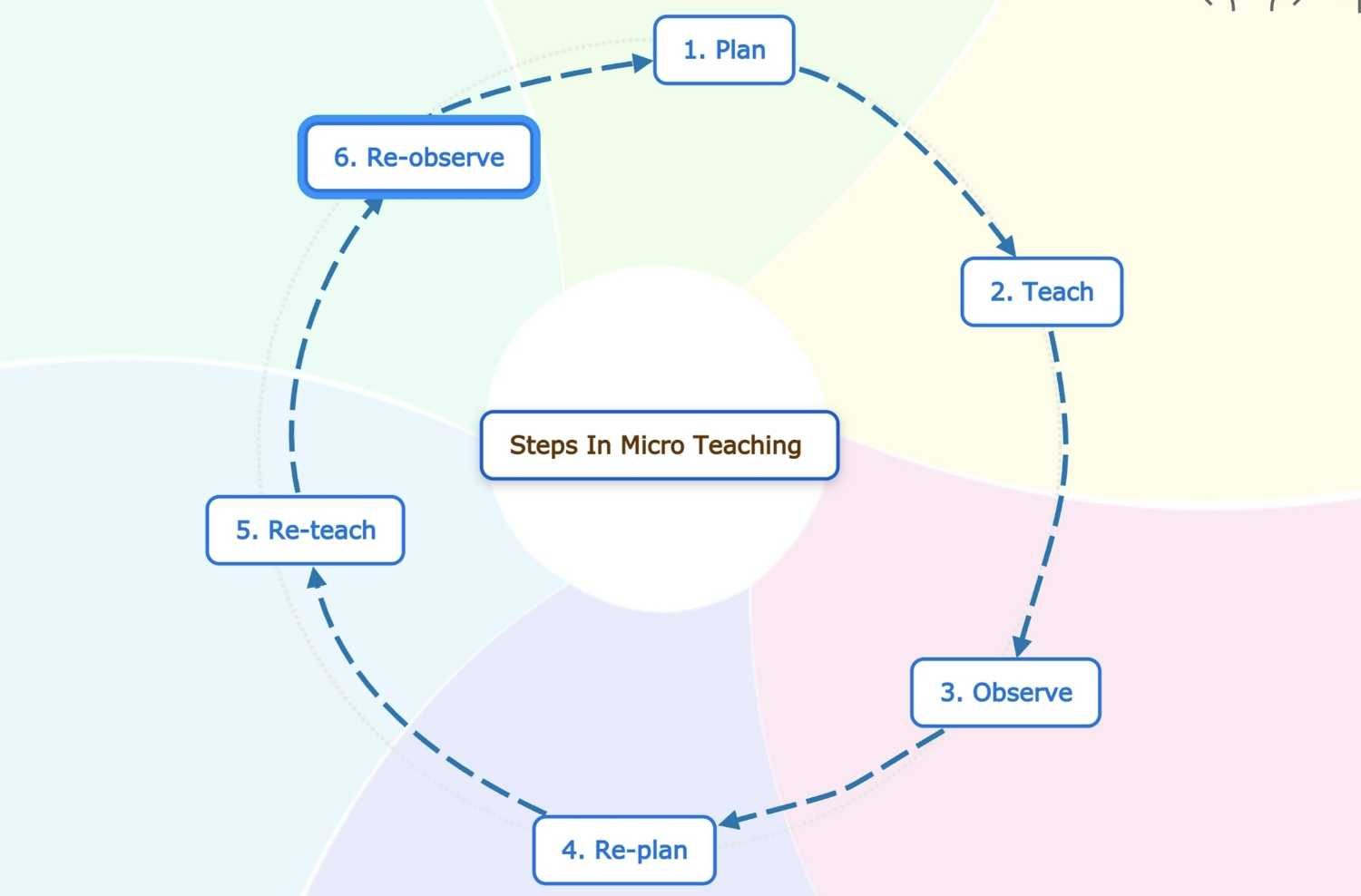Table of Contents
Understanding the Concept of Microteaching
A. Definition of Microteaching
Microteaching Is a special way of teaching practice that focuses on improving specific teaching skills. Imagine you want to become a better teacher. Instead of teaching a whole class for an hour, you teach a small part of a lesson, usually to a small group of students or even your peers, for a short time, like 5 to 10 minutes. This small-scale teaching session is called Microteaching. The main idea is to focus on one particular skill at a time, such as explaining a concept clearly or asking good questions.
By breaking down the teaching process into smaller parts, you can concentrate on improving each part without feeling overwhelmed. After your short lesson, you get feedback from others who watched you. They tell you what you did well and what you can do better. Then, you can try teaching the same lesson again, but this time with the improvements they suggested. This way, you get to practice and improve continuously in a supportive environment.
Microteaching Is like a practice session before the big game. It helps you build your confidence and skills step by step. Whether you’re a new teacher or an experienced one looking to refine your techniques, Microteaching Offers a focused, effective way to become a better educator.
You Might Like: Top 7 + Effective Teaching Methods For Primary Students

B. The Need for Microteaching
You might wonder why we need Microteaching when traditional teaching methods have been around for so long. The answer is simple: teaching is a complex job that involves many different skills, and it’s not always easy to master all of them at once. Microteaching helps by breaking down this big task into smaller, more manageable pieces.
Think about when you learned to ride a bike. You didn’t start by riding down a steep hill. Instead, you practiced in a safe, controlled environment, probably with training wheels at first. Microteaching works the same way. It gives you a safe space to practice and perfect each teaching skill before using it in a real classroom with all its challenges and unpredictability.
As a teacher, you face many different situations in the classroom. You need to explain things clearly, keep students interested, manage the classroom, and assess how well students are learning. Microteaching allows you to practice these skills one at a time. For example, you might spend one session just focusing on how to ask effective questions that make students think deeply about the topic.
Another reason Microteaching is so valuable is the feedback you receive. In a regular classroom, it can be hard to know exactly what you’re doing well and where you need to improve. During a Microteaching session, your peers or mentors watch you closely and give you detailed feedback. This immediate feedback helps you understand your strengths and areas for improvement quickly, making your learning process more effective.
Microteaching also encourages you to reflect on your own teaching. After each session, you can think about what went well and what didn’t, and how you can do better next time. This reflective practice is a key part of becoming a better teacher because it helps you continuously improve.
You Might Like: Innovative Methods for Teaching Mathematics to Kindergarten
History of Microteaching: Tracing Its Origins and Evolution
A. Early Development and Inception
Microteaching started in the 1960s (1963 according to Wikipedia) at Stanford University. Back then, some smart educators wanted to find a way to help new teachers practice their teaching skills without the pressure of a full classroom. They thought, “What if we let teachers practice with a small group and focus on one skill at a time?” This idea was like a breakthrough in teaching methods.
These educators, led by a professor named Dwight W. Allen, created a system where trainee teachers could teach a mini-lesson, get feedback, and then teach it again, better than before. They called this method “Microteaching” because it involved small teaching sessions. It was a new way to give teachers the practice they needed in a controlled and supportive setting. By doing this, they could help new teachers improve their skills step by step.
B. Evolution Over the Decades
Since its start in the 1960s (1963 according to Wikipedia), Microteaching has changed a lot. At first, it was just used in a few teacher training programs in the United States. But as people saw how useful it was, more and more places started to use it. Over the years, the techniques and tools used in Microteaching have improved.
In the beginning, teachers would often just get verbal feedback from their peers or mentors. But as technology improved, people started using video recordings. By recording the Microteaching sessions, teachers could watch themselves and see exactly what they were doing right and what they needed to improve. This made the feedback even more powerful and helpful.
Microteaching also started to include more diverse teaching skills. At first, it focused on basic skills like explaining a topic clearly or managing a classroom. But over time, it began to cover more advanced skills, such as using technology in teaching or dealing with different types of learners. This evolution made Microteaching even more comprehensive and valuable for teachers at all stages of their careers.
C. Global Adoption and Adaptation
Microteaching didn’t stay limited to the United States. As its benefits became clear, educators in other countries started to adopt it as well. You and I can see how practices that work well in one place often spread to others, and that’s exactly what happened with Microteaching.
Different countries and cultures adapted Microteaching to fit their specific needs. For example, in some places, they might focus more on teaching large classes, while in others, they might concentrate on bilingual education. Each adaptation made Microteaching more relevant and effective for the teachers and students in that particular area.
In some countries, Microteaching has become a standard part of teacher training programs. It is recognized as a best practice for helping teachers develop their skills. Educators from around the world share their experiences and improvements, making Microteaching better for everyone.
Importance of Microteaching: Why It Matters in Modern Education
1. Enhancing Teacher Competence and Confidence
You and I both know that teaching is a tough job. Microteaching helps make it easier by improving a teacher’s skills and boosting their confidence. Think of it like practicing a sport. The more you practice, the better you get. In Microteaching, you focus on one small part of teaching at a time. Maybe you practice explaining a tricky concept or managing a lively classroom. By concentrating on one skill, you get really good at it.
When you know you can handle different parts of teaching well, you feel more confident. This confidence shows when you’re in front of a real classroom. You’re not just hoping you can do it; you know you can because you’ve practiced it in a safe setting. This makes you a more competent and confident teacher, ready to tackle any challenge.
2. Providing Constructive Feedback
Getting feedback is crucial for getting better at anything, including teaching. In Microteaching, you teach a short lesson and then get feedback from your peers or mentors. They tell you what you did well and what you can improve. This feedback is like a mirror that shows you how you can get better.
You don’t have to guess what went right or wrong. You get clear, specific advice on how to improve. Maybe they’ll tell you that your explanations are great, but you need to ask more questions to keep students engaged. This constructive feedback helps you understand your strengths and areas where you need to grow.
3. Facilitating Reflective Practice
Reflective practice means thinking about what you did, how it went, and what you can do better next time. Microteaching encourages this kind of thinking. After your mini-lesson, you take some time to reflect. You think about what worked well and what didn’t. You might realize that a certain approach didn’t work, or that you could try a different strategy next time.

This reflection helps you learn from your experiences. It’s not just about repeating the same thing over and over; it’s about getting better each time. By reflecting on your teaching, you become more aware of your methods and more intentional about your improvement. This continuous cycle of teaching, reflecting, and improving makes you a better teacher over time.
4. Preparing Teachers for Real Classroom Challenges
Real classrooms are full of surprises and challenges. Microteaching prepares you for these by giving you a chance to practice in a controlled, supportive environment. It’s like a rehearsal before the big performance. You get to try out different techniques and see what works best.
For example, you might practice how to keep students interested or how to handle disruptive behavior. By doing this in a Microteaching session, you gain experience and build your confidence. When you face similar situations in a real classroom, you’re not caught off guard. You’ve already practiced handling them.
Microteaching also helps you adapt to different types of students and learning styles. You learn how to adjust your teaching methods to meet the needs of diverse learners. This preparation makes you more flexible and effective in the classroom.
Steps of Microteaching: A Detailed Guide to the Process
1. Planning and Preparation
You and I both know that good preparation is the key to success. The first step in Microteaching is planning and preparation. You start by choosing a specific teaching skill you want to improve, like explaining a concept clearly or asking engaging questions. Next, you create a detailed lesson plan for a short session, usually about 5 to 10 minutes long. Think of this lesson plan as your roadmap. It outlines what you will teach, how you will teach it, and what materials you will need. Planning helps you stay focused and organized, making your teaching more effective.
2. Teaching the Lesson
Once you have your plan ready, it’s time to teach the lesson. You will teach a small group of peers or students, focusing on the specific skill you chose. This session is like a mini-lesson, so it’s short and to the point. During this time, you apply the techniques you’ve planned and try to engage your audience. Think of this step as a trial run, where you get to practice your teaching in a safe and controlled environment. The goal is to see how well your plan works in practice and to identify any areas that need improvement.

3. Observation and Recording
While you are teaching, others will observe your lesson. Sometimes, the session is also recorded on video. These observers are usually your peers or mentors, and they watch closely to see how you perform. They take notes on what you did well and where you might need some improvement. The recording, if done, gives you a chance to watch yourself later. Observing and recording are like having a mirror that shows you exactly how you teach. This step is crucial because it provides the raw material for feedback and reflection.
4. Feedback and Discussion
After you finish teaching, you get feedback from your observers. They will tell you what they thought about your lesson, pointing out the good parts and the areas that need improvement. This feedback session is like a friendly chat where you learn about your strengths and weaknesses. You and I know that constructive criticism can help us grow, and this step is all about getting useful advice. You can ask questions, clarify doubts, and discuss different ways to improve your teaching skills.
5. Re-teaching and Refinement
Armed with the feedback, you then refine your lesson plan. You make the necessary changes based on the suggestions you received. After that, you teach the lesson again. This is your chance to apply what you’ve learned and improve your performance. Think of this step as a do-over, where you get to show how much you’ve improved. By re-teaching the lesson, you reinforce the new techniques and make them a part of your teaching style.

6. Re-observation
Finally, after re-teaching the lesson, your observers watch you again. They look to see how well you’ve applied the feedback and whether there are any further areas for improvement. This re-observation step is like a final check to ensure you’ve made progress. You get another round of feedback, which helps you fine-tune your skills even more. This step closes the loop, making sure that the learning process is complete and that you’ve truly improved your teaching abilities.
Types of Microteaching: Exploring Different Approaches
1. Skill-Based Microteaching
In skill-based Microteaching, you focus on one specific teaching skill at a time. For example, you might practice how to ask good questions, how to give clear instructions, or how to manage a classroom. This approach is like focusing on one part of a puzzle until you master it. By concentrating on a single skill, you can improve it more effectively. This type of Microteaching helps you build a strong foundation of essential teaching skills, one step at a time. You and I both know that mastering the basics is crucial before moving on to more complex tasks.
2. Content-Based Microteaching
Content-based Microteaching is all about delivering specific subject matter effectively. Instead of focusing on a particular teaching skill, you concentrate on how to teach a particular topic or lesson. Imagine you need to teach a lesson on photosynthesis in a biology class. Content-based Microteaching helps you practice how to explain this concept clearly, using the right examples and teaching aids. This approach ensures that you can convey your subject knowledge in an engaging and understandable way. It’s like rehearsing a specific part in a play until you get it just right.
3. Video-Based Microteaching
Video-based Microteaching uses video recordings to enhance the learning process. You teach a lesson while being recorded on video. Afterward, you watch the recording to see how you performed. This method is like watching a replay of a game to analyze your moves. You can see exactly what you did well and where you need to improve. Watching yourself teach helps you gain new insights and understand your teaching style better. It’s a powerful tool because it provides a clear, objective view of your performance. You and I both know that seeing is believing, and video-based Microteaching lets you see your progress.
4. Collaborative Microteaching
Collaborative Microteaching involves working with other teachers in a group. You and your peers take turns teaching and observing each other’s lessons. After each session, you give and receive feedback. This approach is like a team practice where everyone learns from each other. Collaboration helps you get different perspectives and ideas on how to improve your teaching. It also builds a sense of community and support among teachers. By working together, you can share best practices and learn new techniques. This collective learning process makes everyone better, creating a positive and enriching experience.
You can also watch the below video, which I found very helpful and available on YouTube.
Pros and Cons of Microteaching: Weighing the Benefits and Challenges
Pros Of Microteaching
1. Focused Practice: Microteaching lets you concentrate on one specific teaching skill at a time. This focused practice helps you improve quickly in a particular area.
2. Immediate Feedback: After each session, you get feedback right away. This helps you understand what you did well and what you need to work on, making your learning process faster and more effective.
3. Boosts Confidence: Practicing in a small, controlled setting helps you build confidence. You get used to teaching and feel more prepared when you face a real classroom.
4. Safe Environment: Microteaching provides a supportive and safe environment to try out new techniques. Mistakes are seen as learning opportunities, so you can experiment without fear.
5. Enhanced Self-Reflection: Watching video recordings of your teaching helps you see your strengths and areas for improvement. This self-reflection is crucial for continuous growth.
6. Collaborative Learning: When done with peers, Microteaching allows you to learn from each other’s experiences. You can share tips, give constructive feedback, and support one another.
Cons Of Microteaching
1. Time-Consuming: Microteaching sessions, feedback, and reflection take time. It can be challenging to fit these into a busy schedule.
2. Limited Scope: Because Microteaching focuses on short lessons, it might not fully prepare you for managing longer, more complex teaching situations in a real classroom.
3. Nerve-Wracking: Being observed and recorded can make you nervous, especially if you’re not used to it. This nervousness might affect your performance.
4. Feedback Quality: The effectiveness of Microteaching depends on the quality of the feedback you receive. If the feedback is not constructive or detailed, it might not help you improve much.
5. Resource Intensive: Setting up Microteaching sessions, especially with video recording, requires resources like cameras, space, and time for reviews. This can be difficult to arrange consistently.
6. Artificial Setting: Microteaching creates a controlled environment that doesn’t always match the complexity of a real classroom. This difference can make it harder to transfer skills directly to actual teaching situations.
Skills Developed Through Microteaching: Building a Competent Teacher
1. Communication and Presentation Skills
Microteaching helps you become a better communicator. When you practice teaching in small sessions, you learn how to explain things clearly and engage your audience. You practice using your voice and body language to keep students interested. Good communication skills help you connect with your students and make learning more enjoyable.
2. Classroom Management and Discipline
Managing a classroom is a big part of teaching, and Microteaching prepares you for this challenge. You learn how to create a positive learning environment where students feel comfortable and focused. By practicing in a controlled setting, you can try different strategies for handling disruptions and keeping the class on track. This skill is essential for maintaining order and helping students learn effectively.
3. Lesson Planning and Organization
Effective lesson planning is crucial for teaching success, and Microteaching teaches you how to plan and organize your lessons efficiently. You learn how to structure your teaching time, choose the right materials, and set clear learning goals. Planning ahead helps you deliver lessons that are engaging and meet educational objectives. Microteaching allows you to refine these skills through practice and feedback.
4. Adaptability and Problem-Solving
Teaching often requires thinking on your feet and adapting to unexpected situations. Microteaching helps you develop these adaptive skills. As you practice teaching different skills and topics, you learn how to adjust your teaching approach based on student responses and classroom dynamics. This adaptability is key to keeping lessons effective and engaging.
5. Reflective Practice and Self-Evaluation
Reflecting on your teaching performance is a critical part of professional growth, and Microteaching encourages this reflective practice. After each session, you evaluate your own teaching and receive feedback from others. You think about what worked well and what you could improve next time. This self-evaluation helps you identify strengths and areas for growth, making you a more mindful and effective teacher over time.
Conclusion: The Future of Microteaching in Teacher Education
Looking ahead, Microteaching holds a bright future in teacher education. It’s like a training ground where you and I can practice and improve our teaching skills in a safe and supportive environment. As education continues to evolve, the need for skilled and confident teachers grows. Microteaching helps meet this need by focusing on specific teaching skills and providing immediate feedback. This approach not only builds competence but also boosts confidence in new and experienced teachers alike.
In the future, we may see more advanced technologies being used in Microteaching, such as virtual reality or AI-assisted feedback systems. These innovations could make the learning experience even more personalized and effective. Additionally, as teaching methods and classroom dynamics change, Microteaching will adapt to meet new challenges and opportunities.
Frequently Asked Questions
Video recordings help you see exactly how you teach. It’s like watching a movie of your lesson. You can notice things you did well and areas where you can improve. This visual feedback is very clear and helps you become a better teacher faster.
Micro teaching prepares you by letting you practice teaching in a small, safe setting. You learn how to explain things clearly, manage a classroom, and engage students. This practice builds your confidence so you’re ready for the challenges of a real classroom.
Yes, micro teaching is helpful for both new and experienced teachers. It allows you to focus on specific teaching skills you want to improve. Whether you’re learning new techniques or refining your current ones, micro teaching provides valuable practice and feedback to help you grow as an educator.




